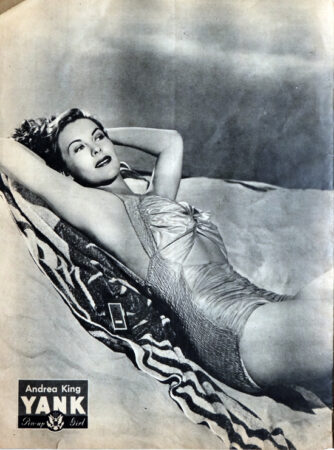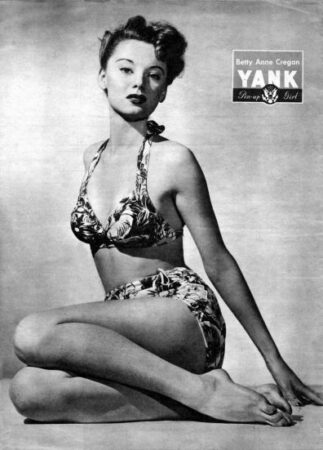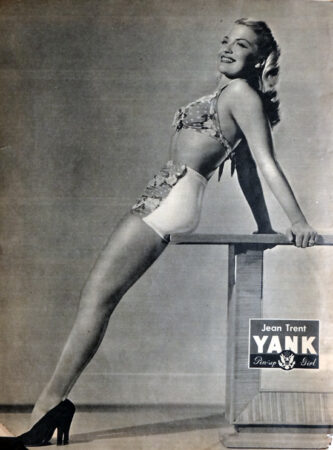The hairy history of swimsuits
Swimsuits and body hair have not always been incompatible. The expectation for women to remove hair before wearing a swimsuit is a relatively recent development.
This extreme modesty was reflected in the bathing machines of the 18th and 19th centuries – carriage-like contraptions that allowed bathers, especially women, to change into swimwear and enter the water while remaining fully covered. The use of such devices demonstrates the cautious norms around swimming attire of the time.
In the late 19th and early 20th centuries, modesty standards meant swimsuits covered most of the body. At Australian beaches in the 1910s, women wore neck-to-knee bathing costumes, while American women donned swimsuits with stockings.
With limited skin exposure, body hair was not a major concern.
This changed in the 1920s, as swimwear shrunk. Sleeveless one-piece suits emerged, exposing underarms. Legs became visible with knee-length hemlines.
As swimsuits revealed more skin, advertisers capitalized on new social pressures.

In 1920s, Gillette ran the first advertisement linking underarm shaving to swimwear. Some of the era’s most direct messaging linking swimsuits and hair removal came from razor adverts like this.
Yet the WWII-era pin-up girls also helped set an unrealistic hairless standard. Cementing this association was the iconic Coppertone advertisement of a dog tugging on a young girl‘s swimsuit to reveal her tan line.

It reinforced the need for swimsuits to cover and conceal the private areas of a woman’s body.
Magazine spreads showed models hair-free in their swimsuits. Screen sirens like Esther Williams reinforced the trend.
Companies like Noxema also ran magazine spreads bluntly instructing women to shave areas like their underarms before wearing swimwear.
The bikini’s introduction in 1946 further tied hairlessness to swim-readiness. By the 1960s, the expectation to shave before wearing any swimsuit – one-piece or two – was firmly entrenched. Ridding swimsuits of hair had become normalized through relentless media messaging.
History makes one thing clear: the origin of public hair removal did not arise organically.
Rather, advertisers constructed the linkage between swimsuits and hairlessness to benefit razor sales.
In doing so, they created lasting social pressures that still compel women to shave before hitting the beach.
The pattern continues today with extremely revealing suits like the thong or micro bikinis requiring the removal of even more body hair to avoid visible strays. The evolution of the swimsuit has unquestionably gone hand-in-hand with intensifying pressures of hairlessness.
The advertising origins of hairlessness
While underarm and leg shaving today feel like standard grooming practices, they did not arise organically. Rather, the origins of linking hair removal to femininity can be traced back to advertising campaigns beginning in the early 1900s. (Source)

With Gillette proactively connecting underarm shaving to wearing fashionable clothing that revealed bare arms and swimwear, beauty writers soon echoed this messaging, instructing women that visibly hairy armpits were unsightly and unfeminine.
Gillette took their messaging a step further by founding the National Hair and Fashion Council in 1940.
This “expert council” reinforced the idea popularized in their ads that removing underarm and leg hair was a necessary part of fashion and hygiene routines for women.
During WWII, the dramatic rise of women entering the workforce led brands to double down on messaging that reinforced traditional femininity. Ads stressed that keeping smoothly shaven legs was part of maintaining a well-put-together, professional appearance.
Brands like Noxema ran magazine spreads showing women shaving their bare legs and underarms before donning fashionable dresses and swimsuits. The caption “Be Your Prettiest!” sent the message that hair removal was essential to summer beauty.
This strategic marketing worked – sales of razors and depilatory products skyrocketed over the 1920s and 30s. Brands eagerly built upon the notion that hairlessness equaled beauty and continued targeting women’s insecurities. (Juliann Sivulka explained how advertising influenced beauty ideals like shaving in detail in her book “Soap, Sex, and Cigarettes: A Cultural History of American Advertising”)

Brands like Nair and Veet also appealed to women’s desire for quick, easy hair removal in magazine spreads. By claiming their products were painless compared to shaving, they provided a “solution” to the hair growth advertisers had convinced women was unsightly.
Magazine spreads and movie star pin-ups set an unrealistic norm that NOT shaving was embarrassingly abnormal.
Advertisers created a problem for profit, then sold the solution.

Contrastingly, ads geared towards men from the same era lacked messaging about any need to remove underarm, leg, or chest hair. This highlights the gender double standard inherent in the beauty norms being constructed solely for women by brands.
Modern advertisements may not be as overt, but the association between hairlessness, beauty and confidence constructed decades ago remains. Ads for razors, waxing and laser treatment echo the messaging that removing body hair boosts self-esteem.
The social pressure to conform
While the expectation for women to remove body hair before wearing a swimsuit originated with advertising, this beauty standard now exerts immense social and cultural pressure on women as well.
Hairlessness has become so ingrained as the feminine ideal that many women feel intense embarrassment at the thought of having visible body hair in a swimsuit.
So where does this pressure stem from?
For younger girls, messaging from media and peers equating hairlessness with beauty and femininity, learned from an early age, informs the perception that body hair is undesirable. The lack of visible female body hair in advertising, movies, and magazines acts as a conditioning agent regarding societal preferences.
Friends discussing shaving routines or making negative comments about hairy legs/armpits also propagates the stigma.
As a result, girls learn that avoiding humiliation means conforming to hair removal, especially when wearing revealing clothing like swimsuits.
For adult women, the pressure manifests through judgmental comments from partners regarding grooming habits.
The continuation of youthful, hairless ideals for women into middle age and beyond also perpetuates the shame associated with natural growth.
Underpinning these attitudes is the pernicious notion that body hair on women is inherently unattractive, while men’s body hair represents masculinity.
Aside from external judgment, women themselves frequently express disgust towards their own body hair, apologizing for skipped hair removal routines. This internalized stigma stems from cultural conditioning that hair equals uncleanliness.
Of course, the true purpose of swimwear is a comfort during activities like swimming, tanning and beach play. When the focus shifts to anxiety about hair exposure, it undermines this functional aim.
Women deny body hair’s normalcy and then suffer discomforts like rashes, razor burn, and ingrown hairs in order to conform.
The social penalties and loss of autonomy associated with natural hair growth demand examination. As body positivity gains ground, the constructs keeping hairlessness as the status quo must be questioned.
True confidence emerges when refusing to conform to arbitrary beauty ideals. Challenging stigmas through visibility and education are the first steps towards change.
The gender double standard
While female body hair is stigmatized as unattractive and unfeminine, male body hair faces no such societal scorn. This imbalance highlights the policing of women’s, but not men’s, appearances and “acceptability”.
Advertising in the early 20th century focused solely on convincing women that underarm and leg hair was embarrassing, sloppy and unhygienic. No similar messaging targeted men, even as sleeveless tops and shorts styles also gained popularity for them.
This construct quickly equated hairlessness with femininity in the cultural consciousness. The notion that women naturally have less body hair set an unrealistic standard, despite the biological reality that both sexes grow the same hair before removal practices.
The demand placed disproportionately on women to remove hair is further evidenced by statistics. A 2021 survey found that “53% of Americans say women should get rid of their armpit hair” and “59% say half of Americans say women should get rid of their armpit hair”

The clear imbalance in grooming expectations highlights the unique pressure on women.
Of course, societal scorn does target some men who dare to have non-conforming visible body hair. Men with hirsutism or those of some ethnicities face assumptions of being “too hairy”. Even male celebrities get chided for excess chest rug or bushy beards deemed unattractive.
However, these exceptions mainly prove how narrowly body hair conforms to hegemonic masculinity without similar criticism. Men enjoy far more latitude when it comes to making grooming choices without judgment.
This double standard also extends to swimsuits in particular. Hairy male celebrities like Martin Lawrence, Sean Connery and Sacha Baron Cohen wearing tiny Speedos spark curiosity, not widespread disgust. But mere stray leg stubble peeking on a female celebrity garners shaming.
Likewise, shaving company Billie’s 2019 ad campaign showing women with actual body hair drew controversy for visible razor stubble. The talks over such ordinary and trivial features spotlight the unique scrutiny women face.
Of course men CAN shave or wax body hair if they choose without stigma, as personal preference. But societal EXPECTATIONS demand women engage in hair removal, denying them equal freedom over their natural bodies. This imbalance merits challenge.
True equality means deconstructing gendered assumptions equating beauty and femininity with hairlessness. With an informed perspective, female body hair can be recontextualized as just another facet of diversity to accept, rather than judge.
Embracing choice and body autonomy
At the crux of the debate around hair removal for swimsuits is the issue of choice and bodily autonomy.
While social pressures certainly influence women’s grooming decisions, the ultimate decision of what to do with one’s own body hair should be a personal one free of coercion.
Women have numerous valid reasons for removing or not removing body hair, whether for swimsuits or any occasion. Those decisions warrant respect either way.
However, the pervasive stigma surrounding female body hair often limits that choice. A fear of judgment or harassment based on cultural norms hinders truly free choice and expression.

Concerns about hygiene also infringe on autonomy. The notion that body hair is inherently dirty has been propagated for decades via advertising and media messaging. In truth, washed and dried hair on any area of the body is clean and poses no health issues. Suggesting otherwise imposes an arbitrary standard.
Likewise, the idea that hair removal is necessary for swimwear to look or function properly does not stand up to scrutiny. Swimsuits are designed as performance gear for surfing waves, diving in pools and more – not evaluating attractiveness. Whether sporting hairy legs during laps or bare legs during tanning, swimwear serves its function.
Reducing natural hair growth to a problem in need of a solution is a narrative that ultimately profits brands selling hair removal products. But women should feel empowered to make choices based on their own preferences, not a corporate agenda.
Part of embracing body autonomy means accepting diversity in beauty. Just as differences in skin tone, body size and proportions all contribute to the spectrum of appearances, so does hair’s presence or absence on one’s body.
Promoting narrow, exclusive standards of attractiveness harms those who fall outside them.
Yes, avoiding stubble regrowth or hiding stray hairs may seem easier than defiantly sporting fuzz. But fostering true acceptance means eventually normalizing all bodies, not just those meeting an arbitrary ideal.
That empowerment must begin with individual mindset shifts. Getting comfortable with one’s body first involves acknowledging societal conditioning around beauty standards.
Developing confidence then allows shedding external opinions like excess baggage.
From there, each woman must feel free to choose what feels most comfortable and aligned with her self-love.
For some that may be regular hair removal, while others embrace natural growth as their preference. Both should be respected.
No choice around hair removal or body presentation should be made from coercion, fear or shame. Women have the right to bare (or not bare) their bodies on their own terms. Realizing that autonomy amidst imposing social pressures is difficult but priceless.
The path to truly free choice is through radical body acceptance – of both yourself and others. Tearing down cultural stigmas that limit women’s options enables empowerment. Only by moving beyond hierarchies of beauty can all women confidently embrace their hair and bodies on their own terms.
The truth about hair removal and hygiene
“The purpose of pubic hair is to protect us, just like the hair around your ears, nose, and eyes.” Dr. Holly W. Cummings wrote in her guide to pubic hair care. “There is nothing dirty or unclean about pubic hair. There is no medical reason to remove it.”
Another argument commonly wielded against female body hair is that it is unhygienic or unhealthy.
In fact, removing body hair can even pose risks when performed too aggressively.
The assumption that hair removal improves cleanliness relies on the premise that hair itself is dirty.
Any hair on the body when properly washed is clean. Hair does not spontaneously produce secretions or attract germs differently than the surrounding skin. Keeping hair trimmed can allow thorough washing access.
Some argue that removing underarm hair reduces body odor, but shaving does not address the root cause. Sweat itself and bacterial interaction cause odor, not hair which simply wicks moisture away. Proper cleansing neutralizes any potential odor on hair.
Ingrown hairs, which frequently result from shaving, waxing or epilation, have a much higher risk of infection due to embedded follicles. Razor burn also poses risks of opening protective skin barriers. So hair removal can actually introduce health issues that natural hair growth does not. s
Beyond the misconception of increased cleanliness, removing hair also provides no medical advantages according to dermatological experts. Unless directed for surgical or angiological purposes, shaving offers no health or skin benefits to warrant depilating without personal preference.
For women with sensitive skin, curly hair or darker complexions, shaving and other hair removal methods often lead to adverse effects like irritation, razor bumps and folliculitis. Letting hair remain may be the healthier choice to prevent such issues.
Hair also serves protective biological functions. Arm, leg and torso hair assist with temperature regulation by trapping heat close to the body and wicking away sweat. Pubic hair offers cushioning and protection for sensitive genital areas. Eyelashes, eyebrows, and nose hairs filter irritants and prevent debris from entering airways and eyes.
Of course, individuals who practice body hair removal can take steps to mitigate risks like moisturizing and exfoliating. But removing hair out of presumed hygiene concerns lacks scientific backing. Maintaining good washing habits is sufficient for health regardless of hair preferences.
Women should feel empowered to style body hair based on personal comfort and choice, not misinformation. Where on the spectrum from hairless to luxuriantly hairy one lands reflects individual expression, not health or hygiene status.
Diverse representation in swimwear
As social stigmas around female body hair face challenges, the swimsuit industry also bears responsibility for shifting beauty ideals.
While advertisers have long amplified hairlessness pressures, many brands are now leading the charge for inclusive representations. Swimwear marketing needs to celebrate the diversity of women’s bodies and choices without judgment.

For too long, swimsuit brand imagery exclusively featured models with a narrow ideal body type and no visible body hair, and it constructed unrealistic expectations that all women must modify their natural features to wear swimwear “acceptably”.
Brands have the power to shatter this myth through inclusive advertising.
Some trailblazing companies are doing just that by showcasing models of diverse races, ages, sizes and abilities wearing swimsuits confidently with natural body hair intact.
Many brands start photographing models with actual arm and leg hair stubble that women experience between shaving sessions. Presenting natural hair growth and razor bumps promotes normalizing real over artificial perfection. Some of the inclusive designs also cater to trans and non-binary individuals’ needs.

Expanding representation also means featuring models of color who encounter Eurocentric stigmas around hair textures and growth patterns.
Swimwear fashion should celebrate, not penalize, natural diversity.
Brands embracing body positivity point to resulting sales boosts, proving financial incentives for inclusion. When customers feel recognized by advertising, they reward those companies with loyalty.
The truth is that swimsuit marketing remains far from fully representative. There are some big names that still lag behind featuring non-conforming bodies. But the visibility of diverse models empowers more companies to expand the definitions of beauty.
Individuals can also apply pressure through careful consumption. Seeking out body positive brands sends the message that all potential customers deserve respect and care.
Mindful shopping habits inform more ethical business practices.
Beyond advertising, promoting hair autonomy means designing functional swimwear free of judgment. Fabrics with compression or smoothing solely to hide hair or jiggle send regressive messages.
And Focusing technical design purely on performance and comfort celebrates natural diversity.
Empowering women to make personal choices around beauty routines, grooming and swimwear requires an inclusive industry consistently representing the spectrum of women.
As leaders, swimsuit brands should acknowledge diversity as an asset, not an inconvenience.
The rules of style and taste shift with each generation. But respecting individual preferences and bodily autonomy as sacrosanct will always remain in swimwear fashion.
Everyone should feel free to be hairy and happy
The pressure put upon us to remove body hair before wearing a swimsuit warrants earnest re-evaluation.
No single choice around grooming and hair removal is inherently right or wrong. The freedom to determine preferences for one’s own body should be held as an inviolable right.
What feels most aligned with self-love and comfort may change over time or situation. The key is upholding bodily autonomy against coercive expectations.
Exposing the arbitrary social constructions that equate hairlessness with beauty and femininity allows more space for challenging conformity.
By recognizing the flaws in conditioning that hair is “unprofessional” or “unattractive”, we can shed stigma and shame.
Likewise, understanding the role advertising played in profiting from hair removal allows clearer seeing of its agenda.
When hairless ideals are reframed as a strategy for sales over societal need, the power of its messaging diminishes.
Although shedding generational standards is easier said than done, progress begins with awareness. The more women who understand the origins of restrictive mandates, the less influential they become.
From there, each woman must define beauty, hygiene and swim-readiness on her own terms.
This may include hair removal for comfort and personal preference – so long as the motivation arises from autonomy, not coercion.
No choice around swimwear should be driven by fear of judgment, harassment or ridicule based on cultural constructs.
All bodies deserve respect and safety regardless of grooming practices. Building alliances and advocating for equality disrupt restrictive systems.
Growth occurs where confidence triumphs over self-consciousness and comparison. The path to body liberation is choosing your comfort and preferences unapologetically.
Beauty standards must adapt to match the diversity of their source – humans in all their glorious multiplicities.
To companies promoting narrow physical ideals for profit, consumers can respond with mindful spending.
Ethical businesses embracing inclusive marketing and designs earn trust and dollars.
Imagine the freedom when hair no longer determines being “swimsuit ready” or not. With informed understanding, let go of hair hang ups. Do what your body loves in its natural state.
No shame, no discomfort, no inhibition – just joyful freedom to be hairy and happy.







